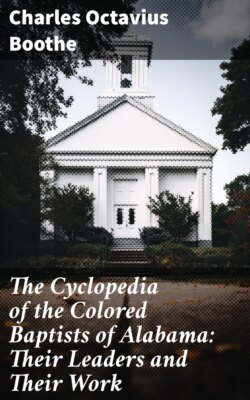Читать книгу The Cyclopedia of the Colored Baptists of Alabama: Their Leaders and Their Work - Charles Octavius Boothe - Страница 8
CHANGES.
ОглавлениеIn order to give a glancing look at the progress and decline of slavery in the North, and at the sort of fruit the gospel was bearing in the soul and conduct of the slave, I copy the following from the “Baptist Home Missions in America” (Jubilee volume):
“By 1776 there were about 300,000 slaves in America. In 1793 there were comparatively few slaves to be found in the Northern States. * * * In 1790 there were 697,897 slaves in the United States; of this number there were 17 in Vermont, 158 in New Hampshire, 2,759 in Connecticut, 3,707 in Pennsylvania, 11,423 in New Jersey, and 20,000 in New York. * * * Before 1830 slavery disappeared from all the Northern States. In Vermont it was abolished in 1777; in Massachusetts in 1780; while acts for the gradual emancipation of slaves were passed in other States—in New York, 1799; in New Jersey, 1804. The final act of abolition in New York being passed in 1817, declaring all slaves free on July 4, 1827.
“The native African, fresh from his fetich worship, and incapable of comprehending even common religious statements, seemed an unpromising subject even for the Christian philanthropist. But, though degraded, he is recognized as human, sinful, accountable, in need and capable of redemption through Christ. The obligation to bring him to a knowledge of the truth as it is in Christ, is practically recognized by many Christian ministers as well as by many pious masters and mistresses. At family devotions in many Christian households the domestics are called in to hear the Scriptures read and bow reverently as prayer is offered to God. On Sunday in the same meeting house master and slave listen to the same sermon. Those who give evidence of conversion are received into the church on relation of their experience after baptism, and sit with their masters at the Lord’s table.
“The First Colored Baptist Church of Savannah, Ga., dates its organization from 1788. Other colored Baptist churches appear in various parts of the country; in Portsmouth, Va., in 1798; the Second African of Savannah, in 1803; the Abysinian Church of New York City, in 1803; the African or Independent Church, Boston, Mass., in 1805; First African of Philadelphia, Pa., in 1809; the First African of St. Louis, in 1827; the Ebenezer of New York City, in 1825; the Union Church of Philadelphia, and a church in the District of Columbia, in 1832.” One in Mobile in 1839, of which in 1848, it is said: “They have a fine house of worship built by themselves, and some excellent leaders or licensed preachers among them.”
Hon. A. H. Curtis, Ex-Senator to Alabama Legislature from Perry County.
We have it on good authority, that in 1850, there were in America about 150,000 negro Baptists. Thus we see that in 230 years the gospel of Christ, though hampered by the institution of slavery, had done much to redeem the fetich worshiper from his midnight darkness and consequent spiritual ruin—had done much to induce the black man to obtain and retain God in his knowledge.
Often we come upon plants which refuse to give out their sweetness so long as their parts are unbroken and unbleeding, but which will quickly yield up their odors when bruised. So it is with men. It is worthy of notice that these dark days of slavery gave birth to some strong colored preachers. Among others, the following are mentioned by their white brethren: Rev. George Leile, of South Carolina, who visiting Savannah, Ga., about 1782 or 1783, baptized the famous Rev. Andrew Bryan, of whom the Savannah Association, (white) in 1812, made the following mention: “The association is sensibly affected by the death of the Rev. Andrew Bryan, a man of color, and pastor of the First Colored Church in Savannah. This son of Africa, after suffering inexpressible persecutions in the cause of his Divine Master, was at length permitted to discharge the duties of the ministry among his colored friends in peace and quiet, hundreds of whom through his instrumentality were brought to the knowledge of the truth as it is in Jesus.”
In 1820, the Board of the Baptist General Convention of America adopted as their missionaries Revs. Collin Teague and Lot Cary, brethren of color, from the Baptist church of Richmond, Va. These men sailed from Norfolk, Va., to Liberia, Africa, in January, 1821. Rev. Thomas Paul, who was pastor of the church in Boston from 1805 to 1830, is spoken of after a very praiseworthy manner. Touching our own State, we begin at Mobile.
